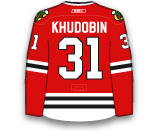
NHL Transactions & Roster Moves


It is unclear why Joseph Woll has been recalled from the Toronto Marlies (AHL) as Matt Murray was expected to start Saturday. Updates should be provided before warmups tonight. The 24-year-old returns to the Maple Leafs, where he was 2-1-0 with a 2.04 GAA and .938 SV%.

Edvinsson has five goals, 22 assists, 50 PIMs and a -3 plus/minus through 51 games with Grand Rapids (AHL) and has been recalled for the first time to the Detroit Red Wings. The 20-year-old was the Red Wings' 2021 first-round (sixth overall) pick.

Czarnik had 14 goals, 23 assists, eight PIMs and a -4 plus/minus through 43 games with Grand Rapids (AHL) and has been recalled Friday to Detroit. He returns to the Red Wings, where he collected two goals and an assist across 15 games earlier in the year.

Foote has 18 goals, 12 assists, 25 PIMs and a +3 plus/minus through 49 games with Utica (AHL) and has been recalled to New Jersey Friday. He returns to the NHL, where he played three games earlier in the season, failing to pick up a point.

With the two-game suspension of Jordan Binnington, Hofer will get his first call-up to St. Louis of the season Thursday from Providence (AHL) on emergency conditions. The 22-year-old had a 22-14-4 record, .920 SV% and 2.50 GAA with Providence prior to his call-up.

Afanasyev failed to pick up a point in three games with the Nashville Predators and will return to Milwaukee (AHL) Thursday after being reassigned to the minors. The 22-year-old returns to the AHL, where he had 13 goals and 13 assists, across 55 games played prior to his callup.

McCarron had two goals, six points and 19 PIMs across 13 games with the Milwaukee Admirals (AHL) and has been recalled to Nashville Thursday. The 28-year-old returns to the Predators, where he had a goal and an assist to go along with 24 PIMs and a -4 plus/minus through 19 games this season.

Greig is back with the Senators and is skating on the second line with Alex DeBrincant and Claude Giroux in the Senators morning skate. The 20-year-old picked up one goal and three assists (four points) with Ottawa earlier in the season, spending most of the year in the AHL. He has 27 points (13G / 14A) in 35 games with Belleville.

Lyon is 3-2-1 with a 3.89 GAA and .892 SV% and has been reassigned to Charlotte (AHL) Wednesday so that he can see some game action instead of backing up in Florida. He returns to the minors, where he was 11-9-1 with a .906 SV% and 2.62 GAA.

Guzda has a 14-7-3 record, 2.85 GAA and .900 SV% with the Charlotte Checkers (AHL) and has been recalled Wednesday to Florida for the first time this season. He will act as a backup to Sergei Bobrovsky and is not expected to see game action during his call-up.

Ersson is 6-1-0 with a 3.07 GAA and .898 SV% but has been reassigned to Lehigh Valley (AHL) Wednesday as Carter Hart (illness) returns to the Flyers. The 23-year-old returns to the minors, where he has a 19-11-1 record, .907 SV% and a 2.61 GAA.

Hayden has 17 goals, 33 points, 58 PIMs and a +10 plus/minus through 47 games with Coachella Valley (AHL) and has been recalled to Seattle for a second time this season. In the 28-year-old's previous showing with the big club this season, he had two goals, and a +2 plus/minus through five games.

Luff had seven goals, 16 assists, six PIMs and a -5 plus/minus through 25 games with the Grand Rapids Griffins (AHL) and was recalled to the Red Wings Monday but has been reassigned to the minor Wednesday. The 25-year-old has a goal over seven games played with the Red Wings.

Czarnik has two goals, three points, 14 SOG, and a +4 plus/minus through 15 games this season but has been reassigned to Grand Rapids (AHL) Wednesday. The 30-year-old returns to Grand Rapids, where he has 13 goals, 23 assists, eight PIMs and a -4 plus/minus through 42 games.

Khudobin was dealt to the Blackhawks at the Trade Deadline as part of the Max Domi deal and had a 13-4-4 record, 2.89 GAA and .899 SV% with the Texas Stars (AHL) and has been recalled to Chicago Wednesday. He will replace the injured Petr Mrazek, who is dealing with a groin injury.



Kesselring has 14 goals, 10 assists, 45 PIMs and a +7 plus/minus through 52 games with Tucson (AHL) and Bakersfield (AHL) and has been recalled by Arizona Tuesday. The 23-year-old had previously played in one game this season, failing to pick up a point.
